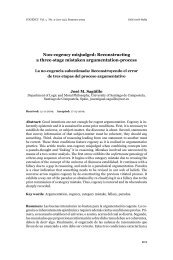Cogency v2 n2
Cogency v2 n2
Cogency v2 n2
You also want an ePaper? Increase the reach of your titles
YUMPU automatically turns print PDFs into web optimized ePapers that Google loves.
David Hitchcock and Bart Verheij (eds.), Arguing on the Toulmin... / J. RITOLA<br />
port teaching, diagramming, storage and manipulation of argument structures<br />
in the two frameworks. But more than that, it offers a mechanism<br />
for interchange and reuse between communities. As an example, Araucaria<br />
has been used to develop a corpus of natural argument, comprising<br />
over 500 analysed extracts from a wide variety of sources in several<br />
languages from around the world. (pp. 357-358)<br />
So, not only are the mechanisms translatable to each other, they are also<br />
translatable to a third mechanism. If the authors are correct, it is difficult to<br />
uphold the view that the theoretical differences involved in the two approaches<br />
about the nature of argument are deep and meaningful. Rather,<br />
this result seems to support the view that as long as we understand that we<br />
have premises, claims, many types of support relations (which have different<br />
reliability figures ranging from zero to one and different conditions of<br />
reliable use), and various ways to support, attack, and defend all these elements,<br />
theoretically it really does not make much of a difference which system<br />
of argument analysis you use, as long as your system can cope with<br />
these elements. This result also casts serious doubt on the contention of<br />
many authors contributing to this book that it is the Toulmin scheme in<br />
itself that allows them to effectively analyze various kinds of arguments,<br />
rebuttals, counter-considerations. To bring this suspicion to a head, we<br />
should ask whether, in analysis of real-life arguments and in theorizing about<br />
the nature of argument, a difference that makes no difference is a difference.<br />
Paglieri and Castelfranchi compare the canonical Alchourrón-Gärdenfors-<br />
Makinson (AGM) belief revision theory with their own Data-oriented Belief<br />
Revision theory (DBR) by applying (what they call) a Toulmin test to both.<br />
This means that they try to represent Toulmin’s lay-out of arguments within<br />
both these models. They conclude that AGM is not able to represent argumentation,<br />
because, first, it does not make any predictions or assumptions<br />
about how and why some propositions come to be believed and why some<br />
are held onto more steadfastly than others (p. 362). Second, AGM does not<br />
take into account other structural properties between beliefs than deducibility.<br />
The two points are obviously intimately connected. Paglieri and<br />
Castelfranchi (pp. 372-376) then further argue that the Toulmin model<br />
should be developed based on observations about the focusing of argumen-<br />
173








